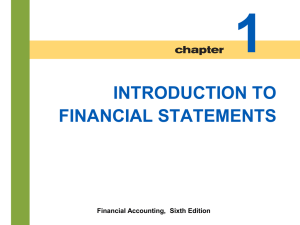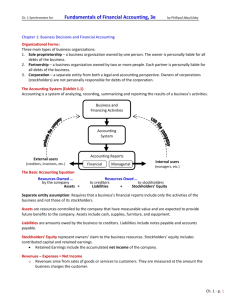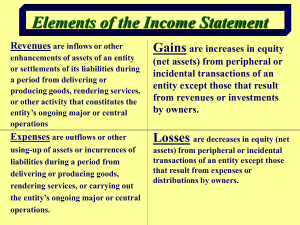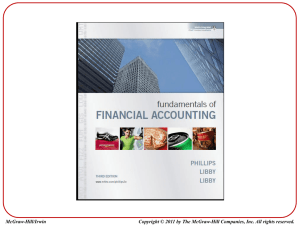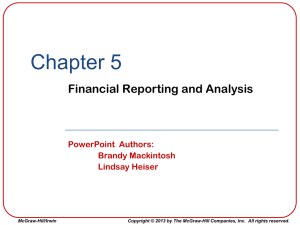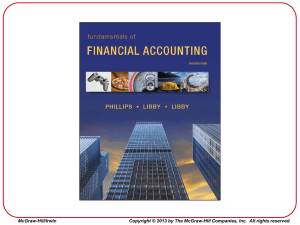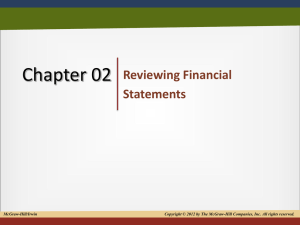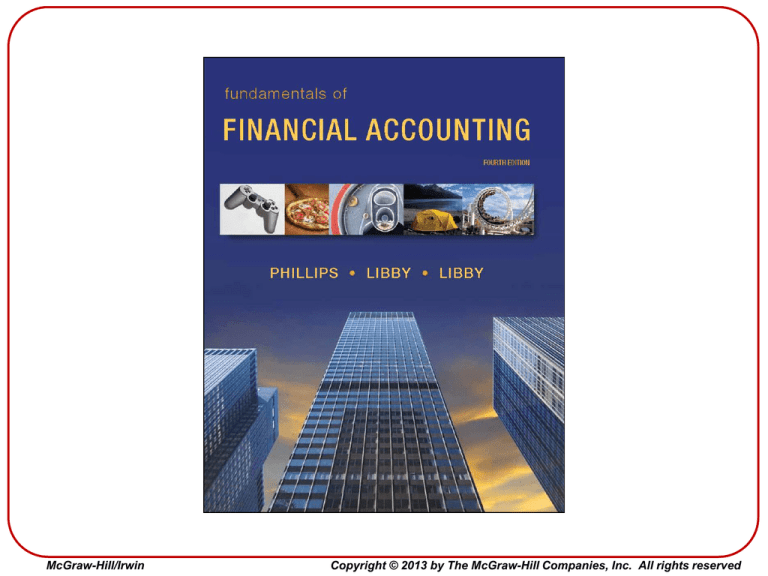
McGraw-Hill/Irwin
Copyright © 2013 by The McGraw-Hill Companies, Inc. All rights reserved
Chapter 1
Business Decisions and Financial
Accounting
PowerPoint Authors:
Brandy Mackintosh
Lindsay Heiser
McGraw-Hill/Irwin
Copyright © 2013 by The McGraw-Hill Companies, Inc. All rights reserved
Learning Objective 1-1
Describe various
organizational forms and
business decision
makers.
1-3
Organizational Forms
Sole
Proprietorship
Business organization owned by
one person. The owner is
personally liable for all debts of
the business.
Partnership
Business organization owned by
two or more people. Each partner
is personally liable for all debts of
the business.
Corporation
1-4
A separate legal entity. Owners of
corporations (stockholders) are
not personally liable for debts of
the corporation.
Organizational Forms
Source: IRS.gov.
1-5
The Accounting System
Operating, Investing and
Financing Activities
Accounting
System
Accounting Reports
External users
(creditors, investors, etc.)
Financial
Managerial
Internal users
(managers,
supervisors etc.)
Accounting is a system of analyzing, recording, summarizing and reporting
the results of a business’s activities.
1-6
Learning Objective 1-2
Describe the purpose,
structure, and content of the
four basic financial
statements.
1-7
The Basic Accounting Equation
Resources Owned . . .
by the company
Resources Owed . . .
to creditors
to stockholders
Assets = Liabilities + Stockholders’ Equity
Separate Entity
Assumption
The financial reports of a
business are assumed to
include the results of only
that business’s activities.
1-8
Assets
Economic resources
controlled by the company
that have measurable value
and are expected to provide
future benefits to the
company.
Cash
Equipment
Supplies
1-9
Furniture
Liabilities
Measurable amounts
owed by the
business to
creditors.
Notes
Payable
1-10
Accounts
Payable
Stockholders’ Equity
Owners’ claim to the
business resources.
Contributed
Capital
Retained
Earnings
Stock Certificate
1-11
Revenues, Expenses and Net Income
Revenues – Expenses = Net Income
Revenues
Sales of goods or services
to customers. They are
measured at the
amount the business
charges the customer.
1-12
Expenses
The costs of doing
business necessary to
earn revenues,
including wages to
employees, advertising,
insurance, and utilities.
Dividends
Distributions of a
company’s earnings to its
stockholders as a return
on their investment.
Dividends are not an expense.
1-13
Financial Statements
Income
Statement
Statement
of Retained
Earnings
Financial
statements are
typically prepared in
this order.
Balance
Sheet
Statement
of Cash
Flows
1-14
The Income Statement
PIZZA AROMA, INC.
Income Statement
For the Month Ended September 30, 2013
Revenues
$ 12,000
Pizza Revenue
12,000
Total Revenue
Expenses
Supplies Expense
Wages Expense
Rent Expense
Utilities Expense
Insurance Expense
Advertising Expense
Income Tax Expense
Total Expenses
Net Income
1-15
5,000
2,000
1,500
600
300
100
500
10,000
$ 2,000
The unit of
measure
assumption
Reports
the
states that
amount
of
results of
revenues
business
less
activities
expenses
should be
for
a period
reported
in an
appropriate
of time.
monetary
unit.
The Statement of Retained Earnings
PIZZA AROMA, INC.
Statement of Retained Earnings
For the Month Ended September 30, 2013
Retained Earnings, Sept. 1, 2013
Add: Net Income
Subtract: Dividends
Retained Earnings, Sept. 30, 2013
$
2,000
(1,000)
$ 1,000
Reports the way that net income and the
distribution of dividends affected the financial
position of the company during the period.
1-16
The Balance Sheet
Reports at a point in time:
1. What a business owns
(assets).
2. What it owes to
creditors (liabilities).
3. What is left over for the
owners of the
company’s stock
(stockholders’ equity).
PIZZA AROMA, INC.
Balance Sheet
At September 30, 2013
Assets
Cash
Accounts Receivable
Supplies
Equipment
Total Assets
$ 14,000
1,000
3,000
40,000
$ 58,000
Liabilities
Accounts Payable
Notes Payable
Total Liabilities
$ 7,000
20,000
27,000
Stockholders’ Equity
Contributed Capital
30,000
Retained Earnings
1,000
Total Stockholders’ Equity
31,000
Total Liabilities and Stockholders’ Equity $ 58,000
BASIC ACCOUNTING EQUATION
Assets = Liabilities + Stockholders’ Equity
1-17
The Statement of Cash Flows
PIZZA AROMA, INC.
Statement of Cash Flows
For the Month Ended September 30, 2013
Cash Flows from Operating Activities
Cash received from customers
Cash paid to employees and suppliers
Cash Provided by Operating Activities
Cash Flows from Investing Activities
Cash used to buy equipment
Cash Used in Investing Activities
Cash Flows from Financing Activities
Capital contributed by stockholders
Cash dividends paid to stockholders
Cash borrowed from the bank
Cash Provided by Financing Activities
Change in Cash
Beginning Cash Balance, Sept. 1, 2013
Ending Cash Balance, Sept. 30, 2013
1-18
$ 11,000
(6,000)
5,000
(40,000)
(40,000)
30,000
(1,000)
20,000
49,000
14,000
$ 14,000
Summarizes
how a
business’s
operating,
investing, and
financing
activities
caused its
cash balance
to change over
a particular
period of time.
Notes to the Financial Statements
Notes help financial statement users
understand how the amounts were
derived and what other information
may affect their decisions.
1-19
Relationships Among the Financial Statements
PIZZA AROMA, INC.
Income Statement
For the Month Ended September 30, 2013
Revenues
Pizza Revenue
Total Revenue
$ 12,000
12,000
Expenses
Supplies Expense
Wages Expense
Rent Expense
Utilities Expense
Insurance Expense
Advertising Expense
Income Tax Expense
Total Expenses
Net Income
5,000
2,000
1,500
600
300
100
500
10,000
$ 2,000
PIZZA AROMA, INC.
Statement of Retained Earnings
For the Month Ended September 30, 2013
Retained Earnings, Sept. 1, 2013
Add: Net Income
Subtract: Dividends
Retained Earnings, Sept. 30, 2013
1-20
$
2,000
(1,000)
$ 1,000
Net income
flows from the
Income
Statement to
the Statement
of Retained
Earnings.
1
Relationships Among the Financial Statements
PIZZA AROMA, INC.
Balance Sheet
At September 30, 2013
Ending Retained
Earnings flows from
the Statement of
Retained Earnings to
the Balance Sheet.
2
PIZZA AROMA, INC.
Statement of Retained Earnings
For the Month Ended September 30, 2013
Retained Earnings, Sept. 1, 2013
Add: Net Income
Subtract: Dividends
Retained Earnings, Sept. 30, 2013
1-21
$
2,000
(1,000)
$ 1,000
Assets
Cash
Accounts Receivable
Supplies
Equipment
Total Assets
$ 14,000
1,000
3,000
40,000
$ 58,000
Liabilities
Accounts Payable
Notes Payable
Total Liabilities
$ 7,000
20,000
27,000
Stockholders’ Equity
30,000
Contributed Capital
1,000
Retained Earnings
31,000
Total Stockholders’ Equity
Total Liabilities and Stockholders’ Equity $ 58,000
Relationships Among the Financial Statements
PIZZA AROMA, INC.
Balance Sheet
At September 30, 2013
PIZZA AROMA, INC.
Statement of Cash Flows
For the Month Ended September 30, 2013
Cash Flows from Operating Activities
Cash received from customers
Cash paid to employees and suppliers
Cash Provided by Operating Activities
Cash Flows from Investing Activities
Cash used to buy equipment
Cash Used in Investing Activities
Cash Flows from Financing Activities
Capital contributed by stockholders
Cash dividends paid to stockholders
Cash borrowed from the bank
Cash Provided by Financing Activities
Change in Cash
Beginning Cash Balance, Sept. 1, 2013
Ending Cash Balance, Sept. 30, 2013
$ 11,000
(6,000)
5,000
(40,000)
(40,000)
30,000
(1,000)
20,000
49,000
14,000
$ 14,000
Assets
Cash
Accounts Receivable
Supplies
Equipment
Total Assets
$ 14,000
1,000
3,000
40,000
$ 58,000
Liabilities
Accounts Payable
Notes Payable
Total Liabilities
$ 7,000
20,000
27,000
Stockholders’ Equity
30,000
Contributed Capital
1,000
Retained Earnings
31,000
Total Stockholders’ Equity
Total Liabilities and Stockholders’ Equity $ 58,000
Cash on the Balance Sheet and Cash at End
of Year on the Statement of Cash Flows agree.
3
1-22
Learning Objective 1-3
Explain how financial
statements are used by
decision makers.
1-23
Using Financial Statements
Creditors
1-24
Investors
1. Is the company
generating
enough cash to
make payments
on its loans? … SCF
1. What is the
immediate return
2. Does the company
have enough
assets to cover its
liabilities? … B/S
2. What is the longterm return (through
(through dividends)
on my
contributions? … SRE
stock price increases
resulting from the
company’s profits)?.. I/S
Learning Objective 1-4
Describe factors that
contribute to useful financial
information.
1-25
External Financial Reporting
Main Goal: Provide useful financial information to
external users for decision making.
Useful
Relevant
1-26
Faithful
Faithful
Representation
Accounting Standards
1-27
World
United
States
Where?
FASB
Who?
IASB
GAAP
What?
IFRS
Ethical Conduct
When faced with an ethical dilemma:
Identify who will
benefit from the
situation and how
others will be
harmed.
Identify the
alternative courses
of action.
Choose the
alternative that is the
most ethical.
1-28
Chapter 1
Supplement
Careers That Depend on Accounting
Knowledge
McGraw-Hill/Irwin
Copyright © 2013 by The McGraw-Hill Companies, Inc. All rights reserved
1-30
Chapter 1
Solved Exercises
M1-12, E1-3, E1-6, E1-8, S1-6 (Req. 1)
McGraw-Hill/Irwin
Copyright © 2013 by The McGraw-Hill Companies, Inc. All rights reserved
M1-12 Preparing a Statement of Retained Earnings
Stone Culture Corporation was organized on January 1, 2012.
For its first two years of operations, it reported the following:
Net Income for 2012
Net Income for 2013
Dividends for 2012
Dividends for 2013
Total assets at the end of 2012
Total assets at the end of 2013
$ 40,000
45,000
15,000
20,000
125,000
242,000
On the basis of the data given, prepare a statement of retained
earnings for 2012 (its first year of operations) and 2013. Show
computations.
1-32
M1-12 Preparing a Statement of Retained Earnings
STONE CULTURE CORPORATION
Statement of Retained Earnings
For the Year Ended December 31, 2012
Retained Earnings, January 1, 2012
$
Add: Net Income
40,000
Subtract: Dividends
(15,000)
Retained Earnings, December 31, 2012
$ 25,000
STONE CULTURE CORPORATION
Statement of Retained Earnings
For the Year Ended December 31, 2013
Retained Earnings, January 1, 2013
$ 25,000
Add: Net Income
45,000
Subtract: Dividends
(20,000)
Retained Earnings, December 31, 2013
$ 50,000
1-33
E1-3 Preparing a Balance Sheet
DSW is a designer shoe warehouse, selling some of the most luxurious and
fashionable shoes at prices that people can actually afford. Its balance
sheet, at January 29, 2011, contained the following items (listed
alphabetically, amounts in thousands).
Accounts Payable
$
149,722
Accounts Receivable
12,514
Cash
93,617
Contributed Capital
Notes Payable
314,382
95,589
Other Assets
692,375
Other Liabilities
122,822
Property, Plant, and Equipment
210,391
Retained Earnings
326,382
Total Assets
Total Liabilities and Stockholders’ Equity
1,008,897
?
Required:
1.
2.
1-34
Prepare the balance sheet as of January 29, 2011 solving for the
missing amount.
As of January 29, did most of the financing for assets come from
creditors or stockholders?
E1-3 Preparing a Balance Sheet
DSW, Inc.
Balance Sheet
At January 29, 2011
(In thousands)
Assets
Cash
Accounts Receivable
Property, Plant, and Equipment
Other Assets
Total Assets
Liabilities
Accounts Payable
Notes Payable
Other Liabilities
Total Liabilities
Stockholders’ Equity
Contributed Capital
Retained Earnings
Total Stockholders’ Equity
Total Liabilities and Stockholders’ Equity
1-35
$
93,617
12,514
210,391
692,375
$ 1,008,897
$
149,722
95,589
122,822
368,133
314,382
326,382
640,764
$ 1,008,897
Most of the financing
as of January 29
came from
stockholders. The
stockholders have
financed $640,764 of
the total assets and
creditors have
financed only
$368,133 of the total
assets of the
company.
E1-6 Preparing an Income Statement and Inferring Missing
Values
Cinemark Holdings, Inc. operates movies and food concession
counters throughout the United States. Its income statement for the
quarter ended March 31, 2011, reported the following amounts (listed
alphabetically in thousands):
Admissions Revenues
Concessions Expenses
Concessions Revenues
Film Rental Expenses
Gen. & Admin. Expenses
$ 311,692
23,282
146,681
165,153
179,047
Net Income
Other Expenses
Other Revenues
Rent Expense
Total Expenses
$
?
24,265
24,763
66,426
?
Required:
1. Solve for the missing amounts and prepare an Income Statement
for the quarter ended March 31, 2011.
2. What are Cinemark’s main source of revenue and two biggest
expenses?
1-36
E1-6 Preparing an Income Statement and Inferring Missing Values
Cinemark Holdings, Inc.
Income Statement
For the Quarter Ended March 31, 2011
(in thousands)
Revenues
Admissions Revenues
Concessions Revenues
Other Revenues
Total Revenues
Expenses
Concessions Expenses
Film Rental Expenses
Gen. and Admin. Expenses
Rent Expense
Other Expenses
Total Expenses
Net Income
1-37
$ 311,692
146,681
24,763
$ 483,136
23,282
165,153
179,047
66,426
24,265
458,173
?
$ 24,963?
E1-6 Preparing an Income Statement and Inferring Missing Values
Cinemark Holdings, Inc.
Income Statement
For the Quarter Ended March 31, 2011
(in thousands)
Revenues
Admissions Revenues
Concessions Revenues
Other Revenues
Total Revenues
Expenses
Concessions Expenses
Film Rental Expenses
Gen. and Admin. Expenses
Rent Expense
Other Expenses
Total Expenses
Net Income
1-38
$ 311,692
146,681
24,763
$ 483,136
23,282
165,153
179,047
66,426
24,265
458,173
$ 24,963
E1-8 Inferring Values Using the Income Statement and Balance
Sheet Equations
Review the chapter explanations of the income statement and the
balance sheet equations. Apply these equations in each of the
following independent cases to compute the two missing amounts
for each case. Assume that it is the end of the first full year of
operations for the company.
TIP: First identify the numerical relations among the columns
using the balance sheet and income statement equations. Then
compute the missing amounts.
Independent
Cases
A
Total
Revenues
$110,000
B
80,000
D
50,000
1-39
Net Income
(Loss)
$82,000
80,000
C
E
Total
Expenses
$150,000
12,000
86,000
81,000
Total
Assets
Total
Liabilities
$70,000
112,000
104,000
Stockholders’
Equity
70,000
26,000
20,000
22,000
77,000
(6,000)
73,000
28,000
E1-8 Inferring Values Using the Income Statement and Balance
Sheet Equations
R – E = NI
Independent
Cases
1-40
Total
Revenues
Total
Expenses
Net Income
(Loss)
A = L + SE
Total
Assets
Total
Liabilities
Stockholders’
Equity
A
$110,000
$82,000
$28,000
$150,000
$70,000
$80,000
B
92,000
80,000
12,000
112,000
42,000
70,000
C
80,000
86,000
(6,000)
104,000
26,000
78,000
D
50,000
30,000
20,000
99,000
22,000
77,000
E
75,000
81,000
(6,000)
101,000
73,000
28,000
S1-6 (Req. 1) Critical Thinking: Developing a Balance Sheet
On September 30, Ashley and Jason started arguing about who is
better off. Jason said he was better off because he owned a
PlayStation console that he bought last year for $250. He figures
that, if needed, he could sell it to a friend for $180. Ashley argued
that she was better off because she had $1,000 cash in her bank
account and a piece of art that she bought two years ago for $800
but could now sell for $1,400. Jason countered that Ashley still owed
$250 on her car loan and that Jason’s dad promised to buy him a
Porsche if he does really well in his accounting class. Jason said he
had $6,000 cash in his bank account right now because he just
received a $4,800 student loan. Ashley knows that Jason also owes
a tuition installment of $800 for this term.
Required:
1. Prepare a financial report that compares what Ashley and Jason
each own and owe on September 30. Make a list of any decisions
you had to make when preparing your report.
1-41
S1-6 (Req. 1) Critical Thinking: Developing a Balance Sheet
Balance Sheet
ASSETS
What is owned
Cash
Console
Art
TOTAL
What is owed
LIABILITIES
Car loan
Tuition Payable
Student Loan
TOTAL
“Net worth”
EQUITY
TOTAL
1-42
Ashley
Jason
$1,000
-0800
$1,800
$6,000
250
-0$6,250
$ 250
-0-0250
1,550
$1,800
$ -0800
4,800
5,600
650
$6,250
End of Chapter 1
1-43

